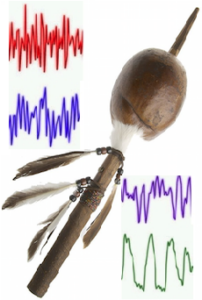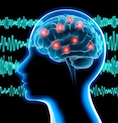 by Paul Robear, President/Executive Director, Cuyamungue Institute by Paul Robear, President/Executive Director, Cuyamungue InstituteAncient cultures used music and sound for many reasons but primarily to influence states of consciousness in ceremonies and as way to promote psychological and physical health. Music, rhythmic drumming, rattling and chanting have been an essential part of most cultures’ rituals and is still in use worldwide. Examples include drumming in certain African cultures, chanting in various religious traditions, and repetitive music in traditional shamanic practices.
In shamanic traditions, drums were used in periodic rhythm to transport the shaman into other realms of reality. The vibrations from this constant rhythm affected the brain in a very specific manner, allowing the shaman to achieve an altered state of mind; a trance state. The interaction between rhythmic sound and the brain involves the synchronization of brainwaves, neural entrainment, and the modulation of neurotransmitters.
In recent time there has been significant research that documents that the rhythmic beat of rattle or drums has a profound effect on our brain activity and induces a profound range of brainwave states. Today, the idea that auditory stimulation can affect mood state and consciousness is widely accepted.
 Rhythmic sound, especially in the form of drumming or repetitive beats, is associated with the induction of theta brainwaves. Theta waves are often linked to states of deep relaxation, meditation, and trance. They are slower in frequency compared to everyday waking states and are believed to be conducive to altered states of consciousness. There is more and more evidence supporting the links between rhythmic sound, brain activity, and altered states of consciousness. And it is part of our mission as an institute to continue exploring the connections among rhythmic sound, brain activity, and altered states of consciousness.
 It was in the early 1970’s, Anthropologist Dr. Felicitas Goodman determined through her research that using a steady rhythmic percussive sound of around 200 to 210 beats per minute was optimum to produce a trance experience. This corresponds well into the Theta brainwave state range of 4 Hz to 8 Hz associated with meditation.. To amplify the experience much like tuning a radio to get a particular station, Dr. Goodman used Ritual Postures to induce a variety of brain states and categories of experiences. The original research into the effects on the human physiology during the practice of Ritual Postures was documented by Dr. Goodman in her book “Where the Spirits Rides the Wind”: https://www.cuyamungueinstitute.com/articles-and-news/original-neurophysiological-research/
|